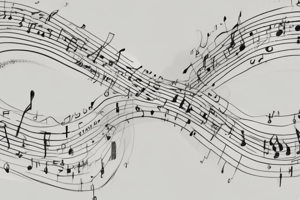Podcast
Questions and Answers
What is the maximum number of sharps or flats that a key signature can have?
What is the maximum number of sharps or flats that a key signature can have?
- 8
- 6
- 7 (correct)
- 5
What is the term for an interval that occurs simultaneously?
What is the term for an interval that occurs simultaneously?
- Diagonal interval
- Melodic interval
- Harmonic interval (correct)
- Syncopated interval
What is the pattern of whole and half-steps in a major scale?
What is the pattern of whole and half-steps in a major scale?
- W-W-H-W-W-W-W
- W-W-H-W-W-W-H (correct)
- W-W-W-H-W-W-H
- W-H-W-W-W-W-H
What type of chord progression involves moving from a dissonant chord to a consonant chord?
What type of chord progression involves moving from a dissonant chord to a consonant chord?
What is the primary focus of harmonic analysis?
What is the primary focus of harmonic analysis?
Flashcards are hidden until you start studying
Study Notes
Key Signatures
- A key signature is a set of sharps (#) or flats (b) that appear at the beginning of a staff to indicate the key of a piece *Sharp (#) raises the pitch of a note, while flat (b) lowers the pitch
- Key signatures can have up to 7 sharps or 7 flats
- The key signature determines the tonality of a piece (major or minor)
Intervals
- An interval is the distance between two pitches
- Intervals can be described in terms of quality (major, minor, perfect, diminished, augmented) and size (number of half-steps)
- Intervals can be classified as:
- Harmonic: occurring simultaneously
- Melodic: occurring in succession
- Intervals can be inverted by switching the order of the pitches
Scales
- A scale is a series of pitches in a specific pattern of whole and half-steps
- Major scales follow a specific pattern: W-W-H-W-W-W-H (whole-whole-half-whole-whole-whole-half)
- Minor scales have three forms: natural, harmonic, and melodic
- Scales can be used to create melodies, harmonies, and chord progressions
Chord Progressions
- A chord progression is a series of chords played in a specific order
- Chord progressions can be used to create harmony and structure in music
- Chord progressions can be classified into different types, such as:
- Tonic-dominant: moving from the tonic chord to the dominant chord
- Circle progression: moving in a circular pattern through the keys
- Resolution: moving from a dissonant chord to a consonant chord
Harmonic Analysis
- Harmonic analysis is the process of examining the harmony of a piece to understand its structure and function
- Harmonic analysis involves identifying:
- Chord progressions
- Key centers
- Functional harmony (tonic, dominant, subdominant)
- Harmonic analysis can be used to:
- Understand the composer's intent
- Identify patterns and motifs
- Inform performance and interpretation
Key Signatures
- A key signature is a set of sharps (#) or flats (b) that appear at the beginning of a staff to indicate the key of a piece.
- Sharp (#) raises the pitch of a note, while flat (b) lowers the pitch.
- Key signatures can have up to 7 sharps or 7 flats.
- The key signature determines the tonality of a piece (major or minor).
Intervals
- An interval is the distance between two pitches.
- Intervals can be described in terms of quality (major, minor, perfect, diminished, augmented) and size (number of half-steps).
- Intervals can be classified as harmonic (occurring simultaneously) or melodic (occurring in succession).
- Intervals can be inverted by switching the order of the pitches.
Scales
- A scale is a series of pitches in a specific pattern of whole and half-steps.
- Major scales follow a specific pattern: W-W-H-W-W-W-H (whole-whole-half-whole-whole-whole-half).
- Minor scales have three forms: natural, harmonic, and melodic.
- Scales can be used to create melodies, harmonies, and chord progressions.
Chord Progressions
- A chord progression is a series of chords played in a specific order.
- Chord progressions can be used to create harmony and structure in music.
- Types of chord progressions include:
- Tonic-dominant: moving from the tonic chord to the dominant chord.
- Circle progression: moving in a circular pattern through the keys.
- Resolution: moving from a dissonant chord to a consonant chord.
Harmonic Analysis
- Harmonic analysis is the process of examining the harmony of a piece to understand its structure and function.
- Harmonic analysis involves identifying:
- Chord progressions.
- Key centers.
- Functional harmony (tonic, dominant, subdominant).
- Harmonic analysis can be used to:
- Understand the composer's intent.
- Identify patterns and motifs.
- Inform performance and interpretation.
Studying That Suits You
Use AI to generate personalized quizzes and flashcards to suit your learning preferences.




